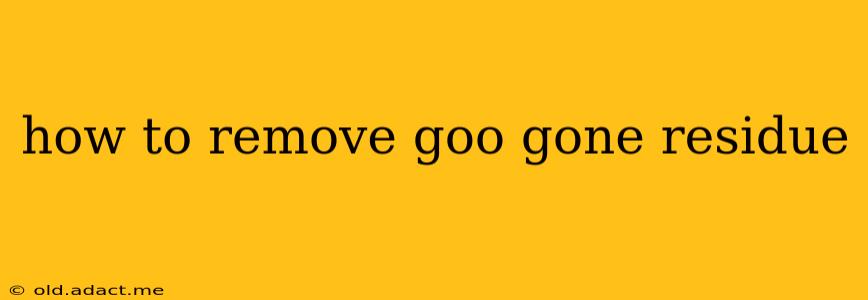Goo Gone is a popular adhesive remover, but sometimes it leaves behind a sticky residue that's just as frustrating as the original mess. Don't despair! This guide provides a range of methods to effectively remove Goo Gone residue from various surfaces, ensuring a clean and streak-free finish. We'll cover everything from simple solutions to more intensive approaches, addressing common questions along the way.
What is Goo Gone Residue?
Goo Gone residue typically appears as a sticky, hazy film left behind after using the product. This happens because the solvent in Goo Gone dissolves the adhesive, but sometimes small amounts of the adhesive or the solvent itself remain on the surface. The residue can be especially noticeable on glossy surfaces like glass or painted surfaces.
How to Remove Goo Gone Residue: A Step-by-Step Approach
The best method for removing Goo Gone residue depends heavily on the surface you're cleaning. Here's a breakdown of effective techniques:
1. Gentle Methods: For Delicate Surfaces
-
Warm, soapy water: For many surfaces, this is your first line of defense. Simply mix warm water with a mild dish soap, apply it to a soft cloth, and gently wipe the area. Rinse with clean water and dry thoroughly. This is ideal for plastic, some painted surfaces, and less delicate materials.
-
Isopropyl Alcohol (Rubbing Alcohol): For slightly tougher residues, try rubbing alcohol. Apply a small amount to a clean, soft cloth and gently rub the affected area. Always test this on an inconspicuous area first, especially with painted surfaces or delicate materials.
2. Intermediate Methods: For Stubborn Residue
-
Baking Soda Paste: Create a paste by mixing baking soda with a little water. Apply this paste to the residue, let it sit for a few minutes to absorb the stickiness, then gently scrub with a soft cloth or sponge. Rinse thoroughly with water and dry. This is effective on many surfaces, but avoid using it on scratched or porous materials.
-
White Vinegar: Similar to baking soda, white vinegar can be effective. Dampen a cloth with white vinegar and gently rub the affected area. Rinse thoroughly with clean water and dry. Again, test in an inconspicuous area first.
3. Advanced Methods: For Extremely Stubborn Residue
- Commercial Adhesive Remover: If the residue persists, consider using a commercial adhesive remover specifically designed for tough sticky substances. Follow the manufacturer's instructions carefully, as these products can be strong. Always test in an inconspicuous area first.
What if Goo Gone Residue is on Fabric?
Removing Goo Gone residue from fabric requires a slightly different approach. Try pre-treating the stain with a laundry stain remover, then washing the garment as usual. For stubborn stains, you may need to repeat the process or use a stronger stain remover, always checking the care label first.
What if Goo Gone Residue is on a Specific Material?
- Glass: Warm soapy water, rubbing alcohol, or a glass cleaner often works well.
- Wood: Test a small area with mild soapy water or white vinegar. Avoid abrasive cleaners.
- Plastic: Warm soapy water is usually sufficient. Rubbing alcohol can be used cautiously.
- Metal: Warm soapy water or a metal cleaner should suffice.
- Painted Surfaces: Start with warm soapy water and carefully proceed to a rubbing alcohol solution if necessary. Always test on an inconspicuous area first to prevent damage.
How to Prevent Goo Gone Residue in the First Place?
- Use sparingly: Apply only the amount of Goo Gone necessary to loosen the adhesive.
- Work in small sections: This allows for better control and prevents excessive product buildup.
- Wipe immediately: Wipe away the loosened adhesive promptly to avoid residue.
By following these steps and choosing the appropriate method for your surface, you can effectively remove Goo Gone residue and restore your surfaces to their original clean condition. Remember to always test any cleaning solution on an inconspicuous area first to prevent damage.
